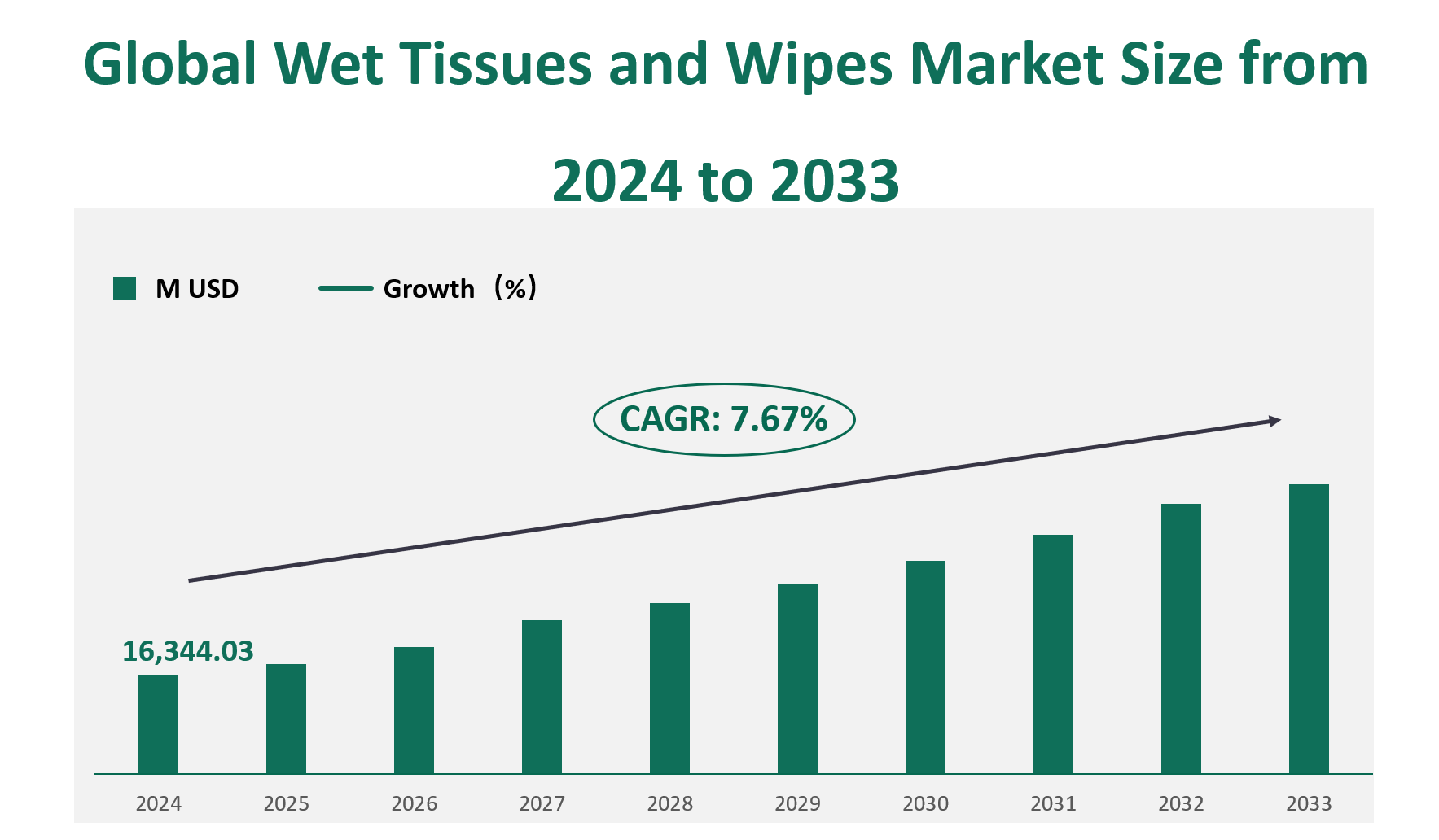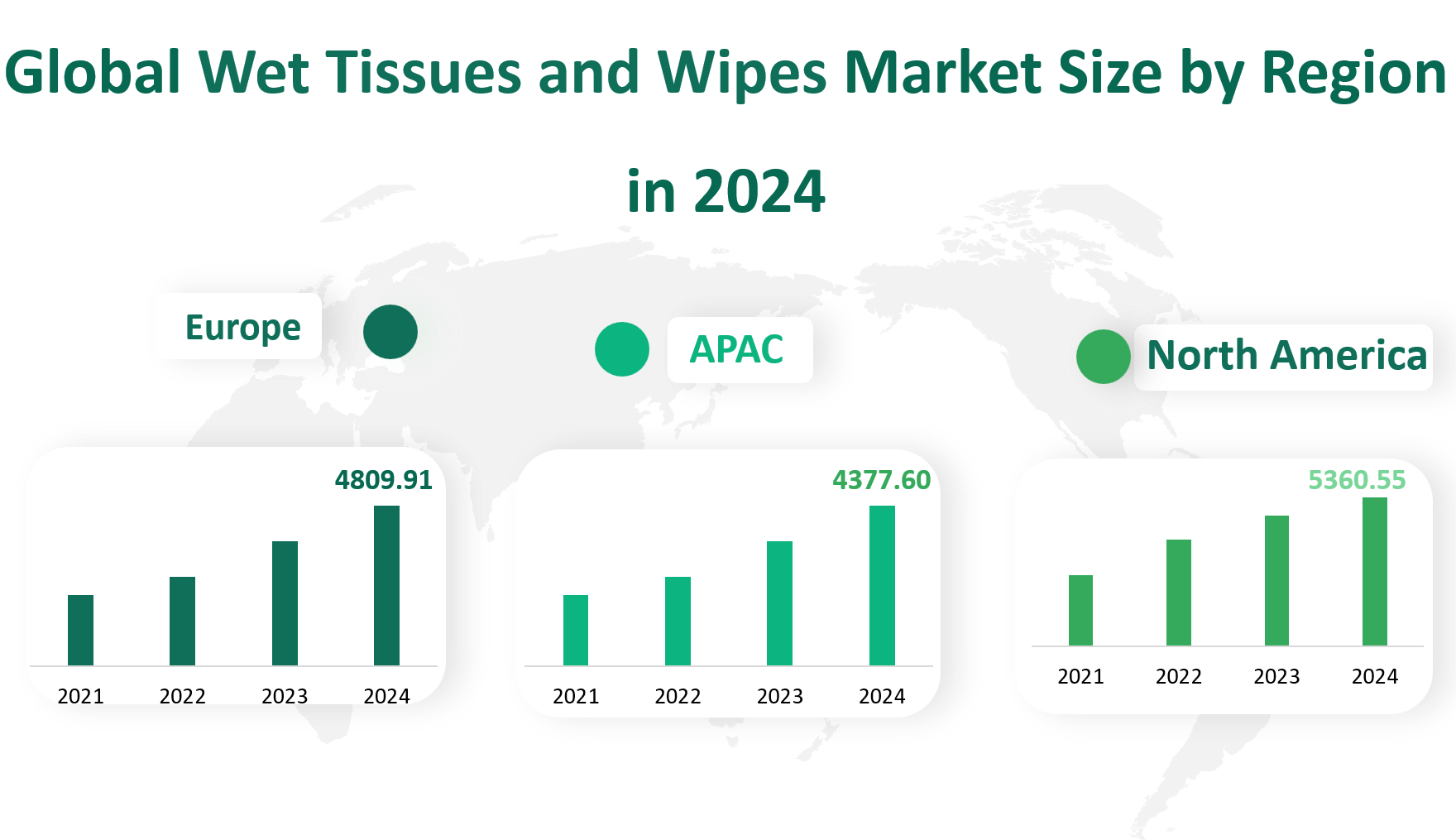1. Global Wet Tissues and Wipes Market Insight Analysis
The global Wet Tissues and Wipes market is a dynamic and evolving sector, driven by increasing consumer demand for convenience, hygiene, and multi-purpose cleaning solutions. Wet tissues and wipes are defined as pre-moistened sheets made from non-woven materials or plastics, designed for various cleaning purposes, including personal hygiene, household cleaning, industrial use, and commercial applications. These products are typically saturated with water or other liquids, such as isopropyl alcohol, to enhance their cleaning and disinfecting capabilities. The market encompasses a wide range of products, from baby wipes and makeup remover wipes to industrial-grade cleaning wipes and disinfectant wipes.
In 2024, the global Wet Tissues and Wipes market revenue is projected to reach 16,344.03 million USD. The market is expected to continue its upward trajectory, with a Compound Annual Growth Rate (CAGR) of 7.67% from 2024 to 2033.
Figure Global Wet Tissues and Wipes Market Size (M USD) and CAGR (2024-2033)

2. Driving and Limiting Factors of Wet Tissues and Wipes Market Growth
Increasing Consumer Awareness: The growing emphasis on personal hygiene and cleanliness has significantly boosted the demand for wet tissues and wipes. Consumers are increasingly looking for convenient and effective cleaning solutions, making wet wipes a popular choice for personal care and household cleaning.
Convenience and Versatility: Wet wipes offer unparalleled convenience, making them ideal for use in various settings, including travel, outdoor activities, and busy lifestyles. Their versatility across multiple applications, from baby care to industrial cleaning, further drives market growth.
Technological Advancements: Innovations in manufacturing processes and materials have led to the development of more effective and environmentally friendly wet wipes. These advancements have not only improved product quality but also expanded the range of available products, catering to diverse consumer needs.
Emerging Markets: Developing regions, particularly in Asia-Pacific, are experiencing rapid growth in the consumption of wet tissues and wipes. The large population base and rising disposable incomes in countries like China and India are driving market expansion in these areas.
Health and Safety Concerns: The COVID-19 pandemic has heightened awareness of hygiene and sanitation, leading to a surge in demand for disinfectant and antibacterial wipes. This trend is expected to continue as consumers prioritize health and safety in their daily routines.
Environmental Concerns: The environmental impact of wet wipes, particularly those that are not biodegradable, has led to increased regulatory scrutiny. Governments are imposing stricter regulations to reduce plastic waste and promote sustainable products, which may limit the market growth of traditional wet wipes.
Product Safety and Quality: The presence of low-quality counterfeit products in the market poses a significant challenge. These products can cause skin irritation and other health issues, leading to consumer distrust and regulatory action.
Economic Fluctuations: Economic downturns and fluctuations in raw material prices can impact the profitability of manufacturers. Higher pulp prices, coupled with low demand growth, can restrain corporate earnings and limit market expansion.
Demographic Trends: Aging populations in developed regions like Japan and the US may reduce the demand for certain types of wet wipes, such as baby wipes, which rely heavily on population growth for market expansion.
3. Technology Innovation and Corporate Mergers and Acquisitions in Wet Tissues and Wipes Market
Sustainable Materials: Manufacturers are increasingly focusing on developing wet wipes made from biodegradable and compostable materials to address environmental concerns. Innovations in fiber technology and the use of natural ingredients are driving the shift towards eco-friendly products.
Advanced Manufacturing Processes: The adoption of advanced production techniques, such as spunlace and airlaid technologies, has improved the quality and performance of wet wipes. These processes allow for the creation of softer, more absorbent, and durable wipes, catering to consumer preferences for high-quality products.
Enhanced Functionality: Technological advancements have led to the development of wipes with specialized functionalities, such as antibacterial, antiviral, and fragrance-free options. These innovations are particularly relevant in the context of the COVID-19 pandemic, where demand for disinfectant wipes has surged.
Strategic Expansion: Major players in the market are engaging in mergers and acquisitions to expand their product portfolios and enter new markets. For example, Kimberly-Clark’s acquisition of Softex Indonesia significantly enhanced its presence in Southeast Asia, a rapidly growing market.
4. Global Wet Tissues and Wipes Market Size by Type
The wet tissues and wipes market is categorized into several key product types, each defined by its unique manufacturing process and end-use properties. These include Spunlace Technology, Airlaid Technology, Wetlaid Technology, Spunlaid Technology, and Others.
Spunlace technology involves using high-speed jets of water to entangle fibers, creating a strong and durable fabric. This process results in a product that is soft, absorbent, and suitable for a wide range of applications, including personal care and household cleaning. In 2024, the market revenue for Spunlace Technology products is projected to reach USD 9,851.2 million.
Airlaid technology is a method of forming a web by mixing fibers with air to create a uniform mixture, which is then deposited on a moving belt. This process produces a soft and absorbent material, ideal for baby wipes, facial wipes, and other personal care products. The market revenue for Airlaid Technology products in 2024 is estimated at USD 2,340.38 million.
Wetlaid technology involves suspending fibers in water and depositing them on a forming wire to create a fabric. This method is commonly used for producing wipes that require high absorbency and strength, such as industrial wipes and heavy-duty cleaning wipes. In 2024, the market revenue for Wetlaid Technology products is expected to be USD 1,746.13 million.
Spunlaid technology involves extruding molten polymer through a die to form continuous filaments, which are then laid down on a moving belt to form a web. This process results in a strong and uniform fabric, often used for wipes that require high strength and durability. The market revenue for Spunlaid Technology products in 2024 is projected to be USD 1,380.82 million.
Table Global Wet Tissues and Wipes Market Size by Type in 2024
|
Market Size (M USD) 2024 |
Market Share | |
|
Spunlace Technology |
9851.20 |
60.27% |
|
Airlaid Technology |
2340.38 |
14.32% |
|
Wetlaid Technology |
1746.13 |
10.68% |
|
Spunlaid Technology |
1380.82 |
8.45% |
|
Others |
1025.50 |
6.27% |
5. Global Wet Tissues and Wipes Market Size by Application
The wet tissues and wipes market is also segmented by various applications, each defined by its specific use case and market demand. These applications include Personal Care, Household, Industrial, Commercial, and Others.
Personal care applications encompass products used for individual hygiene, such as baby wipes, facial wipes, and hand sanitizing wipes. These products are designed to be gentle on the skin while providing effective cleaning and sanitizing properties. In 2024, the market revenue for personal care applications is projected to reach USD 3,647.50 million.
Household applications include wipes used for cleaning surfaces, kitchen and bathroom cleaning, and general home maintenance. These products are designed to be highly absorbent and effective in removing dirt and germs. The market revenue for household applications in 2024 is estimated at USD 5,703.80 million.
Industrial applications involve wipes used in manufacturing, construction, and other industrial settings. These wipes are designed to be durable, absorbent, and capable of handling heavy-duty cleaning tasks. The market revenue for industrial applications in 2024 is projected to be USD 1,862.55 million.
Commercial applications include wipes used in hotels, restaurants, healthcare facilities, and other commercial settings. These products are designed to meet the high standards of cleanliness required in these environments. The market revenue for commercial applications in 2024 is estimated at USD 4,218.19 million.
Table Global Wet Tissues and Wipes Market Size by Application in 2024
|
Application |
Market Size (M USD) 2024 |
Market Share |
|
Personal Care |
3647.50 |
22.32% |
|
Household |
5703.80 |
34.90% |
|
Industrial |
1862.55 |
11.40% |
|
Commercial |
4218.19 |
25.81% |
|
Others |
911.99 |
5.58% |
6. Global Wet Tissues and Wipes Market by Top Regions
North America is a mature and stable market for wet tissues and wipes, driven by high consumer awareness of hygiene and a preference for premium products. The region includes the United States, Canada, and Mexico, with the U.S. being the largest market. In 2024, the market revenue for North America is projected to reach USD 5,360.55 million.
Europe is another mature market for wet tissues and wipes, characterized by high consumer demand for quality and innovation. The region includes countries such as Germany, the UK, France, Italy, and Spain, with Germany being the largest market. In 2024, the market revenue for Europe is estimated at USD 4,809.91 million.
The Asia-Pacific region is the fastest-growing market for wet tissues and wipes, driven by rapid urbanization, increasing disposable incomes, and rising consumer awareness of hygiene. Key markets in this region include China, Japan, South Korea, India, and Southeast Asia, with China being the largest market. In 2024, the market revenue for Asia-Pacific is projected to reach USD 4,377.60 million.
South America is a growing market for wet tissues and wipes, driven by increasing consumer awareness of hygiene and the need for effective cleaning solutions. Key markets in this region include Brazil, Argentina, Colombia, and Chile, with Brazil being the largest market. In 2024, the market revenue for South America is estimated at USD 952.14 million.
The Middle East and Africa region is a growing market for wet tissues and wipes, driven by increasing consumer awareness of hygiene and the need for effective cleaning solutions. Key markets in this region include Saudi Arabia, UAE, Egypt, Nigeria, and South Africa, with Saudi Arabia being the largest market. In 2024, the market revenue for the Middle East and Africa is projected to reach USD 843.83 million.
Figure Global Wet Tissues and Wipes Market Size by Region in 2024

7. Global Wet Tissues and Wipes Market Analysis by Major Players
7.1 Procter & Gamble (P&G)
Company Introduction and Business Overview
Procter & Gamble (P&G) is a multinational consumer goods corporation headquartered in Cincinnati, Ohio, USA. Founded in 1837, P&G is one of the largest consumer goods companies in the world, with a diverse portfolio of products spanning personal care, household cleaning, and healthcare. P&G’s business strategy focuses on innovation, sustainability, and consumer satisfaction.
Products Offered
P&G offers a wide range of wet tissues and wipes products, including baby wipes, facial wipes, and household cleaning wipes. Their well-known brands include Pampers, Always, and Bounty. These products are designed to meet the diverse needs of consumers, from personal hygiene to household cleaning.
7.2 Kimberly-Clark
Company Introduction and Business Overview
Kimberly-Clark is a global leader in the production of personal care and consumer tissue products. Headquartered in Irving, Texas, USA, the company was founded in 1872. Kimberly-Clark’s business strategy focuses on innovation, sustainability, and meeting the needs of consumers through high-quality products.
Products Offered
Kimberly-Clark offers a wide range of wet tissues and wipes products, including baby wipes, facial wipes, and household cleaning wipes. Their well-known brands include Huggies, Kleenex, and Scott. These products are designed to provide effective cleaning and hygiene solutions for consumers.
7.3 Essity
Company Introduction and Business Overview
Essity is a global hygiene and health company headquartered in Stockholm, Sweden. Founded in 2017, Essity’s business strategy focuses on innovation, sustainability, and meeting the needs of consumers through high-quality products. The company operates in several segments, including personal care, consumer tissue, and professional hygiene.
Products Offered
Essity offers a wide range of wet tissues and wipes products, including baby wipes, facial wipes, and household cleaning wipes. Their well-known brands include Tork, Libero, and Lotus. These products are designed to provide effective cleaning and hygiene solutions for consumers.

